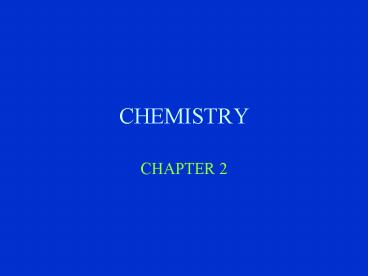CHEMISTRY - PowerPoint PPT Presentation
1 / 18
Title:
CHEMISTRY
Description:
Foods- Lipids. Organic molecules with the elements C, H and O ... Definition: organic catalysts that speed up chemical reactions by lowering activation energy. ... – PowerPoint PPT presentation
Number of Views:49
Avg rating:3.0/5.0
Title: CHEMISTRY
1
CHEMISTRY
- CHAPTER 2
2
Basic concepts in Chemistry
- Matter-anything that occupies space and has
weight. Three states of matter-solid, liquid and
gas. The amount of matter is termed-mass. - Elements-smallest unit of matter. There are 92
naturally occurring elements. Chemical symbols.
Refer to tab2-1 pg. 32 for elements present in
the living organism and their significance.
3
ATOMS
- Atoms-smallest unit of element that retains
properties of the element. - nucleus and electron cloud
- electrons, protons and neutrons
- atomic number and mass number
- isotopes
- energy levels
4
Atoms
- Ions charged atoms. Cations and anions
- Molecules combination of two or more atoms with
a bond. - Free radicals
- compounds a substance that can be broken to two
or more elements. eg. water.
5
Chemical Bonds
- Ionic Bondattraction between two oppositely
charged atoms (ions), cation and anion. - Covalent bondbond formed by sharing of
electrons. - Hydrogen bond a weak attractive force between
hydrogen of one molecule and oxygen or nitrogen
of another.
6
Chemical Reactions
- Definition when new bonds form and old bonds
break between atoms. - reactants and products
- metabolism-anabolism and catabolism
- work
- energy- kinetic and potential
- endergonic vs. exergonic
7
Types of Reactions
- Decomposition AB------gtA B-catabolism
- synthesis A B --------gt AB-anabolism
- exchange AB CD --------gt AC BD
- reversible A B -------gt AB
- redox loss of electrons oxidation
- gain of electrons-reduction
8
Inorganic compounds
- Water and its properties
- high heat capacity
- surface tension
- good solvent
- hydrolysis reactions
- lubricant
- aqueous solutions all nutrients etc. carried in
the blood in the form of aqueous solutions.
9
Acids, Bases Salts
- acids, bases and salts
- acids are substances that release hydrogen ions.
- Bases are substances that release hydroxyl ions
or accept hydrogen ions. - Salts release ions other than hydrogen or
hydroxyl. - pH-measure of hydrogen ion concentration in the
solution. It is a negative log scale. Acids have
pH below 7 and bases have pH above 7.
10
Buffers
- These are substances that resist changes in pH.
- Made of a combination of a weak acid or base and
its salt. - Convert strong acids to weak acids and strong
bases to weak bases. - Most common base found in the living system is
made of carbonic acid and bicarbonate.
11
Organic Chemistry
- Study of carbon and its compounds.
- Organic compounds are largely made of carbon and
hydrogen. They are complex structurally and held
together by covalent bonds. - Carbon skeleton and major functional groups.
- Monomers, polymers, and isomers.
12
Organic compounds
- For each organic compound know what it is, the
major elements, the major types, examples,
functions, where it is located in the body and
foods that contain it. Also be able to recognize
them given the structure. - Four organic compounds are carbohydrates,
lipids, proteins and nucleic acids.
13
Carbohydrates
- An organic molecule that contains the elements
carbon, hydrogen and oxygen in the ratio 121.
Also termed sugars. - Types monosaccharides (glucose, fructose),
disaccharides (sucrose, maltose) and
polysaccharides (starch, cellulose and glycogen). - Energy source, energy storage, stuctural support.
- Foods-
14
Lipids
- Organic molecules with the elements C, H and O
that are insoluble in water. Ratio is not 121.
- Lipids are classified into-fatty acids,
triglycerides, steroids, phospholipids,
prostaglandins. - Energy source, energy storage, insulation, cell
membrane components, hormones. - Foods
15
Proteins
- Organic polymers of amino acids with the elements
C, H, O, N. - peptide bond
- proteins are classified based on their function
-support, movement, transport, buffering,
metabolic regulation, hormones, defense. - Structural organization of proteins- primary,
secondary, tertiary and quaternary. - Denaturation-loss of function due to loss of
shape. - Foods
16
Enzymes
- Definition organic catalysts that speed up
chemical reactions by lowering activation energy. - substrate and products
- names end with the letters -ase.
- activation energy-energy required to start a
reaction. - enzyme activity-lock and key model and
induced-fit hypothesis. - factors that affect enzyme activity temperature,
pH, metals, coenzymes.
17
Nucleic Acids
- Organic polymers of nucleotides with the elements
C, H, O, N and P. - the major types are RNA and DNA.
- DNA -genetic information.
- RNA-protein synthesis.
- Differences between RNA and DNA.
18
Adenosine Triphosphate (ATP)
- This is the energy molecule of life.
- Mostly generated in the mitochondria of each
cell by cellular respiration. - Liberates energy by removal of one or two
terminal phosphate groups. - ATP-----gt ADP P energy
- ADP P energy--------gt ATP. Catalyzed by ATP
synthase.































